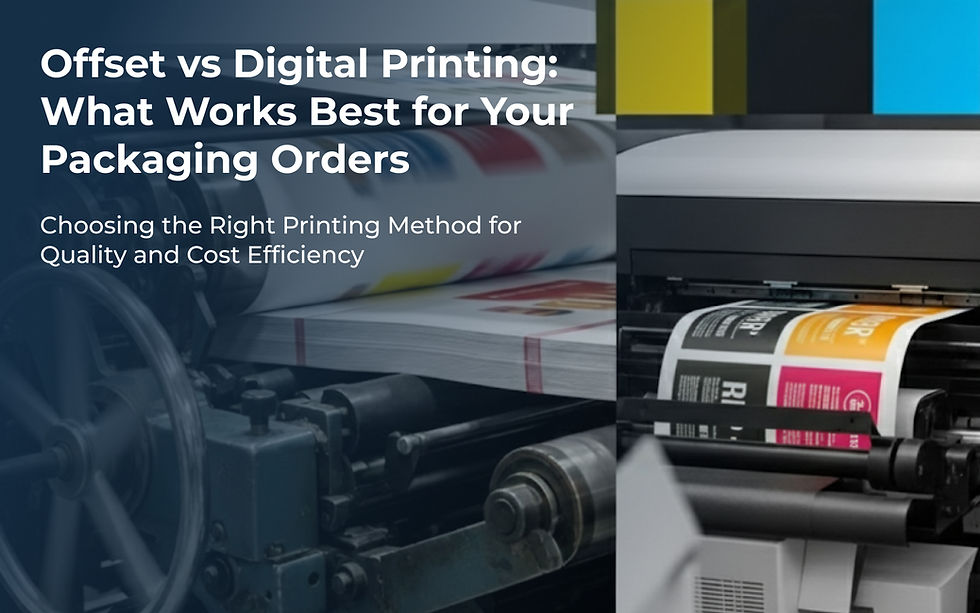Why a CAPA Plan is Essential in Packaging and Manufacturing?
- Kumar Printers Team
- Sep 19
- 3 min read
Updated: Nov 4

In packaging and manufacturing, quality lapses can create significant disruptions across supply chains. Beyond immediate financial losses, they may erode client confidence and damage long-standing business relationships. For this reason, structured problem-solving methodologies such as Corrective and Preventive Action (CAPA) are indispensable.
A CAPA Plan is more than just a quick fix. It is a structured method that ensures problems are not only corrected in the short term but also prevented from recurring in the future. The process essentially involves three critical steps:
Identifying, recording and accurately describing the problem.
Identifying the root cause and understanding why the problem occurred in the first place.
Designing and implementing corrective measures to fix the current occurrence of the problem, and preventive measures to eliminate the likelihood of recurrence.
An effective CAPA Plan requires careful analysis and is a collaborative process across teams. Success is not measured by how quickly the immediate issue is resolved but by whether the corrective actions can truly prevent the same problem from resurfacing. Every step of the process must be documented to build a transparent record of accountability and continuous improvement, as well as for research and learning purposes.
Using the 5 Whys framework to Conduct a Root Cause Analysis: A Case Study at Kumar Printers
Out of the three steps in any CAPA process, the most critical is the root cause analysis (RCA) stage. There are many models for conducting a root cause analysis, including the 5-Whys and the fishbone diagram.
At Kumar Printers, we applied the 5 Whys analysis model to investigate an issue of wet and crumbled shippers in a packaging batch for one of our customers. Here’s how the process unfolded:
Step 1: Describe the issue
Problem Statement: Finished product shipper cartons were received in a damaged, wet, and crumpled condition at the client's factory.
Step 2: Investigation and RCA
We conducted a physical inspection of the storage area, damaged material and the transport vehicle and were able to arrive at the root cause of the problem through the following 5 whys.
Why 1: Why were the shippers wet? Because water seeped into the packaging during transport.
Why 2: Why did water seep into the packaging? Because there was a gap in the body of the vehicle (the transport vehicle was not in good condition at the time of loading)
Why 3: Why were cartons packed in a damaged vehicle? The loading team was not aware of the vehicle damage.
Why 4: Why did the loading team not detect damage to the vehicle? Visual inspection of the vehicle was not conducted before the loading.
Why 5: Why was the vehicle inspection not carried out? Because responsibility for vehicle inspection was not fixed in the dispatch/ vehicle loading SOP.
By the fifth “why,” we have determined that the root cause of the issue was an insufficiently or poorly designed vehicle loading standard operating procedure (SOP).
The CAPA Plan in Action
With the root cause identified, the CAPA Plan was developed and implemented as follows:
Corrective Action: Immediate segregation of damaged shippers and re-shipment of goods to the client. Feedback was given to the commercial vehicle supplier on the damaged truck.
Preventive Action: Vehicle loading SOP was amended to include a checkpoint and checklist for visual inspection of all vehicles before commencing loading & the warehouse team was trained based on the updated SOP.
Documentation: The entire process—from problem identification to resolution—was recorded in a CAPA register, serving as proof of corrective measures as well as a point of additional reference for continuous improvement in the future.
Why This Matters?
By applying the CAPA framework with the 5 Whys model, we not only resolved a costly incident but also strengthened our factory's long-term quality management system. Instead of treating the issue as an isolated mishap, the team transformed it into a learning opportunity that improved processes, reduced risk, and reinforced accountability.
In industries such as packaging, where precision and trust are the foundation of success, this approach ensures that mistakes do not define outcomes. Instead, they become catalysts for smarter systems, stronger teams, and better results. Also read: Offset vs Digital Printing: What Works Best for Your Packaging Orders?

Comments